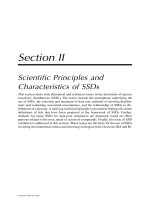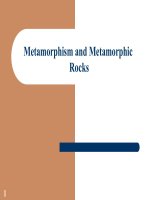Metamorphic rocks in thin section
Bạn đang xem bản rút gọn của tài liệu. Xem và tải ngay bản đầy đủ của tài liệu tại đây (7.2 MB, 49 trang )
METAMORPHIC
ROCK IN THIN
SECTION
Contents Image scales (field width)
Al-silicates
Other aluminous minerals
Amphiboles
Pyroxenes
Sheet silicates
Epidotes
Oxides
20x = 6 mm
40x = 3 mm
100x = 1 mm
200x = 0.5 mm
400x = 0.25 mm
1000x = 0.1 mm
Al-silicates
Andalusite in a muscovite-biotite schist. Note the diamond-shaped inclusion cloud to
the bottom left, which is the center of the crystal, and the inclusion trails that radiate from
the corners of the diamond. This is known a "chiastolite cross". Note the small garnet
just to the below the diamond. Two {110} cleavages intersecting at approximately right
angles are visible. Andalusite has lower relief than the other Al-silicates.
Plane polarized light, 20x
NEIGC84-C5-2
Andalusite in a muscovite-biotite schist. Note the isotropic garnet, and the inclusion-rich
area at the top-right. Birefringence is first order white to pale yellow, much like quartz
and feldspars but with higher relief and very different habit (even when not big, blocky
crystals).
Cross polarized light, 20x
NEIGC84-C5-2
Kyanite in a muscovite-biotite schist. The four kyanite crystals are colorless, have high
relief, and two have a strong cleavage parallel to their length. Relief is much higher than
muscovite, which surrounds the kyanite.
Plane polarized light, 40x
TMW96-C4b
Kyanite in a muscovite-biotite schist. The kyanite crystals are have interference colors
up to upper 1st order, much lower than the surrounding muscovite. Most sections yield
slightly inclined extinction, as expected from its triclinic symmetry.
Cross polarized light, 40x
TMW96-C4b
Sillimanite fibers (variety fibrolite) in a biotite-andalusite-muscovite schist. Sillimanite is
colorless, has relief much higher than muscovite. In medium-grade rocks sillimanite is
typically in this fibrous variety. Sillimanite fibers can be included in many minerals, and
can survive retrograde metamorphism in garnet and quartz.
Plane polarized light, 200x
JBT2-XA
Sillimanite fibers (variety fibrolite) in a biotite-andalusite-muscovite schist. Sillimanite
has birefringence up to 2nd order blue, somewhat higher than kyanite and much higher
than andalusite. Extinction is parallel as required by its orthorhombic symmetry. These
fibers are so thin they scarcely have any birefringence.
Cross polarized light, 200x
JBT2-XA
Sillimanite prisms in a biotite-garnet-cordierite schist. This granulite facies schist has
very coarse sillimanite prisms which can be seen in long section and in their diamond-
shaped cross sections.
Plane polarized light, 40x
WE-1
Sillimanite prisms in a biotite-garnet-cordierite schist. The lower second order blue
birefringence can be seen in the longitudinal sections.
Cross polarized light, 40x
WE-1
Sillimanite and andalusite in a biotite-muscovite-andalusite schist. The large high-relief
(grayish) patches are andalusite, which are surrounded by a coarse muscovite rim
(lower right). The andalusite is partially pseudomorphed by sillimanite, which are high-
relief, colorelss diamond shapes.
Plane polarized light, 20x
JBT2-XA
Sillimanite and andalusite in a biotite-muscovite-andalusite schist. In this view the
andalusite are the large gray areas (mostly), and the sillimanite pseudomorphing
andalusite are the vertically elongated white diamonds scattered throughout the upper-
left half of the image.
Cross polarized light, 20x
JBT2-XA
Other aluminous minerals
Cordierite in a garnet-cordierite-biotite schist. Cordierite is colorless, and relief is similar
to plagioclase feldspars and quartz, but it tends to be dustier than either of these other
two minerals.
Plane polarized light, 40x
WE-1
Cordierite in a garnet-cordierite-biotite schist. Birefringence is up to 1st order white, like
plagioclase and quartz, and can have polysynthetic twinning (center) that resembles
plagioclase. Note that there can be THREE directions of polysynthetic twinning,
contrasting with none in quartz and typically two in feldspars.
Cross polarized light, 40x
WE-1
Cordierite in a garnet-cordierite-biotite schist. Magnified view of yellow pleochroic halos
surrounding radioactive inclusions.
Plane polarized light, 200x
WE-1
Cordierite in a garnet-cordierite-biotite schist. The pleochroic halos around radioactive
inclusions are typically brownish or purplish in cross polarized light.
Cross polarized light, 40x
WE-1
Staurolite in a muscovite-biotite schist. Staurolite has parallel extinction and one
cleavage parallel to its length, and has a characteristic pale to darker golden yellow
pleochroism. This example has a twin, highlighted by different color and birefringence
caused by its different orientation.
Plane polarized light, 20x
Gassetts Schist
Staurolite in a muscovite-biotite schist. The birefringence of staurolite is similar to that of
kyanite, upper 1st order.
Cross polarized light, 20x
Gassetts Schist
Chloritoid in a muscovite-chlorite phyllite. The pale blue to yellow pleochroism of the
chloritoid, and its high relief, contrasts sharply with the lower relief, pale yellow to green
pleochroic chlorite. This grain has prominent twinning, evident in parallel stripes having
somewhat different pleochroic colors.
Plane polarized light, 20x
IMA96-C1-1
Chloritoid in a muscovite-chlorite phyllite. The low first-order birefringence is somewhat
higher than that of most chlorite, and much lower than muscovite. The polysynthetic
twinning and the somewhat anomalous first order interference colors of chloritoid are
visible.
Cross polarized light, 20x
IMA96-C1-1
Chloritoid in a muscovite-chlorite phyllite. Closeup showing green chlorite between
bluer and much higher relief chloritoid.
Cross polarized light, 100x
IMA96-C4B
Tourmaline in a muscovite-biotite schist. Tourmaline occurs as elongate to stubby
prisms having hexagonal or triangular cross sections. They are typically zoned in shades
of blue, green, or brown.
Plane polarized light, 200x
East Clairindon, VT
Tourmaline in a muscovite-biotite schist. Tourmaline has no cleavage (though
commonly cross fractures), and has negative elongation.
Cross polarized light, 200x
East Clairindon, VT
Tourmaline in a muscovite-biotite schist. Tourmaline is unusual among common
elongate minerals in having its strongest absorption when the plane of light polarization
is perpendicular to the crystal length. This is the opposite of micas and most amphiboles.
Plane polarized light, 200x
East Clairindon, VT
Tourmaline in a muscovite-biotite schist. Tourmaline is pale-colored when the plane of
polarization is parallel to its length.
Plane polarized light, 200x
East Clairindon, VT
Amphiboles
Actinolite in a greenstone. These actinolite crystals are very pale green, and here occur
as stubby crystals. These are probably pseudomorphs after augite phenocrysts in the
basalt protolith.
Plane polarized light, 40x
NNH-3









